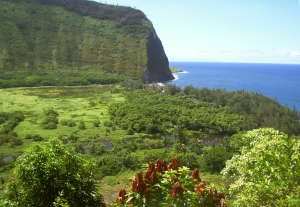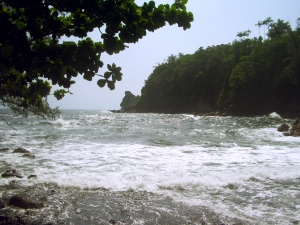The Hamakua Coast, running up the windward side of the Big Island from just north of Hilo to the north tip island at Upolu Point, is one of the most magical, enchanting and memorable parts of the Big Island. To few people take the time to really see the depth and grandeur of the Hamakua District. Once the center of the sugar industry in Hawaii, Honoka'a, and the rest of District comprised of sweeping farm land, torrid jungle canyons and thousand foot lacy waterfalls, sank into pot-plantation era torpor, alowing the decades to simply wash over it. Experiencing a resurgence of energy, population and interest, Hamakua is remaiking itself as a tourist mecca and growing community of entrepreneurs, Eco-friendly industries and boutique agricultural businesses. You owe it to yourself to discover, explore and fall in love with this unique and special part of the Hawaii's Big Island.
Pepe’ekeo Scenic Drive
Located just a few minutes north of Hilo on Highway 19, this “Old Road through Old Hawai'i”, a four-mile-half hour scenic wander, parallels Highway 11 but is removed worlds away from the traffic and hustle along the main road. Rolling along old cane fields, jungle-canopied in places, passing waterfalls and crossing creeks, the Pepe’ekeo Scenic Drive is a special treat for the visitor who may be thinking they waited a century too long to visit Hawai'i. On a sunny day, on a rainy day, it doesn’t matter; this scenic drive is a joy.A scenic overlook of Onomea Bay, near the head of the trail, reveals the wildly scenic, untamed coastline and canyon mouth, beckons casual hikers to explore Onomea Bay.
Onomea Bay Trail
Only a few miles north of tame and sedate Hilo Bay, Onomea Bay is subject to the full fury and magic of the open Pacific Ocean. Rugged, jagged, majestic, the wickedly sculpted cliffs along the bay belie the easy 15 minute walk down to the beach. Accessible to most walkers of even marginal condition, the trail leads alongside a botanical garden (be sure not to wander through any their gates unless you are a paying customer) and falls forthrightly down to the canon mouth, past a tiny waterfall at the end of the stream and to the beach. A lovely walk and a wildly inspiration place; if you have an extra forty minutes to spare, this walk is well worth the time.The fishing here is great but we don’t recommend swimming here due to the currents and rip-tides.
Akaka Falls
There is a reason that Akaka Falls rates as the most visited tourist site on the island of Hawai’i. Simply put, the 420 foot, free falling plunge of clear water down a fern festooned cliff is an amazing and beautiful site. Leaving the parking lot, the loop trail immediately splits. Going left through fern, ginger, impatiens and bamboo, one reaches Akaka Falls in 5-8 minutes of ambling. If you turn right, the trail loops up and down some hills, through a wonderful jungle of flowers, ferns, heliconia, palms and bamboo to 100 foot tall Kahuna Falls in about 15 minutes of walking; Akaka Falls is then reached by following the same path another 5 minutes and 5-8 minutes after that you are back at the parking lot.Almost every town in Hawai’i has a “Wainuenue street”. From the Hawai’ian syllables “wai” meaning “fresh water” and “nue” meaning “colorful” or “dancing”, the word “wainuenue” refers to the rainbow seen in waterfalls. If you are lucky, and approach Akaka Falls on a sunny morning when the sun shines into to grotto, you may be blessed with seeing this lovely Hawai’ian icon, the wainuenue.
When visiting Akaka Falls, be sure to save some time to explore the shops, galleries and cafes of Honomu on the way back to the highway; it’s unlike anywhere you’ve ever been before…guaranteed.
Hakalau Beach Park
Oh, wow! Most definitely the tropical paradise you dreamed about visiting, this thick, lush jungle canyon is a stunning remnant of Old Hawai'i, leading along a rushing stream to a narrow canyon festooned with tropical blossoms, vines and palms to a sandy beach where the surf is nothing short of amazing.Although locals surf and swim unconcernedly here, the visitor is advised to admire the water, but not go in. Not only are the waves, currents and tides lethally treacherous here, but stream mouths and murky water are prime hunting grounds of Hawai'i’s own tiger, Mano, the shark.
There are no services at Hakalau Beach.
Laupahoehoe Train Museum
Back in the day, built around the turn of the century, various train lines nearly circumnavigated the Big Island, carrying raw cane to refineries and sacks of sugar to quaysides dotted here and there around the island. The coming of a large military presence during the Second World War was marked by an era of road building which more or less obviated the need for the trains. Tracks and trestles were cannibalized for wood and metal in the war effort and slowly the Big Island train industry was groaning to an ignoble halt when the tidal wave of 1946 destroyed much of the remaining track; today the carcass of Big Island railroading is all but pillaged into oblivion.
Here at Laupahoehoe, preserved alongside the one-time loading platform, is the Laupahoehoe Train Museum, stuffed full of interesting artifacts and photos and staffed with enthusiastic, well-informed, fun--- and did we mention enthusiastic?—docents. Look for “Old Rusty” outside the museum—a restored engine and caboose.
Laupahoehoe Train Museum and its associated gift shop, featuring many handcrafted gift items made by local artisans, are open daily, from 9 am to 4:30 pm on weekdays, and from 10 am to 2 pm on weekends. Public restrooms are available. Admission is $3.00 per adult and $2.00 for students and seniors.
Kalopa Native Forest State Park and Recreation Area
A small park with numerous hiking trails, Kalopa showcases the upland, tropical forest of the northeastern part of Hawai’i Island. Amenities include picnic tables, tent camping and small, if somewhat ragged, cabins for rent, a wonderful forest ambiance and absolute silence. This a great place to escape the rattle and hum of East Hawai’i.Honoka’a Town
Built in the era of great plantations and left culturally and economically isolated after the collapse of the sugar industry, until recently Honoka’a and the Hamakua Coast were content to drowse along through the decades. A boom in real estate and a return of vital human energy to the area has made a literal renaissance of the town of Honoka’a. A bustling hub, it boasts numerous wonderful restaurants, gift and boutique shops and the highest density of antique shops on the island. Be sure to stop to explore a little, have a meal or do some shopping in scenic Honoka’a on your way to or from Waipi’o Valley…it’s a fun, happening kind of place. Just remember, it’s a “happening kind of place” in the Hawai’ian sense—which means a little laid back, and always steeped with aloha.Waipi’o Valley
Waipi’o Valley is arguably the most magical place on the Big Island. The steep canyon walls and verdant fields of the valley floor, the mile long black sand beach and numerous immense waterfalls that line the valley walls all call out to the visitor for exploration.Always listed among the most beautiful spots in the State of Hawai’i, this valley is as hauntingly lovely as it is difficult to see in its entirety.
Although the mile-long black sand beach is gorgeous, the forest and jungle canyon floor and walls amazing and the numerous, high-flying waterfalls compelling, it's a long and steep hike down in, and an equally long, but much more arduous, hike out. The road is windy and dangerous to drive...we don't recommend it.
Tours down into the valley in vans, on horse drawn wagons and ATVs can be booked in Honoka’a. Over-flights in fixed wing aircraft and helicopters also offer fine venues from which to see this amazing piece of Hawai’i.
For more information on traveling to Hawaii in general or touring the Big Island in particular, visit http://tourguidehawaii.com or www.lovingthebigisland.wordpress.com.
About the Author: Popular television personality and award-winning independent filmmaker Dr. Donald B. MacGowan originally pursued a career in academics, earning two B.Sc. degrees, a dual M.Sc., and a PhD.; co-authoring over 5.2 million dollars in grants, and publishing more than 200 refereed journal articles, abstracts, etc. Gaining sanity somewhere in that process, he quit the academic rat race and began to live. Donnie is an accomplished, prolific alpinist, having climbed on 5 of the seven continents, putting up more than 150 first ascents on rock, ice and snow, and a dozen first ski descents. He has written, directed and produced short and feature length films on health, travel, mountaineering and life in a touring rock band. Donnie records and tours relentlessly with his Celtic Punk fusion band "Fatal Loins"--although nobody much seems to care for their music. A Hawaii resident since 2000, he quietly and humbly inhabits Kailua Kona, doing environmental good works, surfing the be-jeezis out of the local waves and frenetically producing somewhat bizarre and mildly disturbing programs for local television which have recently been lauded as: "Ignorant", "Arrogant" and "Totally Insane". You may say what you wish about him, Donnie does not care. For somewhere underneath those swaying palm trees, in those warm aloha breezes, he is far too busy praying for good surf to hear you...















